Art Sets.
In one drop of water: children’s labels
Print this setBy the Art Gallery of NSW
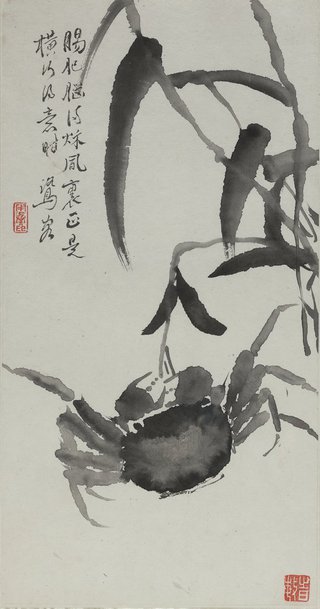
AGNSW collection Wang Yongyu Crab and grass
Describe the different inky shapes and marks on this painting.
This hanging scroll from China shows a crab under some reeds and leaves. The shapes of the crab’s claws and many legs mirror the curving shapes of the elongated leaves. The ink creates a watery pattern on the crab’s shell. The delicate marks of the calligraphy, or beautiful writing, add to the overall harmony of the painting. Notice how much detail has been captured by Wang Yongyu’s few brushmarks.
Spot his red seals, like a signature, at the top and bottom.
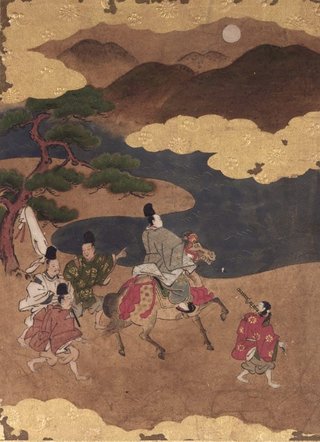
AGNSW collection Tosa School Episode from ‘Akashi’ (Chapter 13) of the 'Tale of Genji' late 17th century
Notice all the curving shapes and scalloped edges in this painting. Can you spot the moon?
This Japanese painting shows a view looking down through some golden clouds to a group of people travelling by moonlight. The painting is inspired by a chapter from a classic Japanese story known as the Tale of Genji. It depicts Genji on horseback with his servants and a priest travelling to meet the priest’s daughter. Notice how the patterns and colours of their clothes and the floral shapes on the clouds add to the decorative quality of the scene.
Look at their expressions. What do you think they could be talking about?
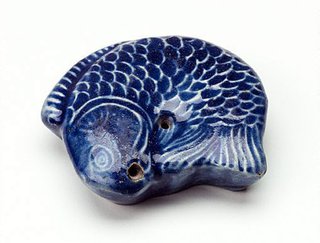
AGNSW collection Water dropper moulded in the shape of a fish 19th century
Look closely at the shape and detail of this little fish.
Water droppers like this were used by Korean scholars, known as ‘sonbi’. The sonbi used them for mixing ink for painting and for calligraphy – the decorative writing that appears on many of the artworks in this exhibition. Water droppers would sit on the scholar’s desk, so their decorative quality was important. They were often designed using symbolic animals. Fish don’t close their eyes when they sleep, so in Korean culture they are a symbol of continuous effort and self-discipline – essential qualities for a scholar.
What animal could be a symbol for your personal qualities?
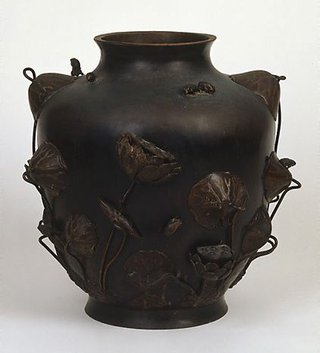
AGNSW collection Meiji export ware Large vase decorated with sculptured lotus and frogs and incised water pattern and water plants 19th century
What do you think this object is made from?
This vase is made from copper alloy, a type of metal. It was made in Japan over 100 years ago. When the Edo period ended in 1868, the warrior class was disbanded, or split, and the carrying of swords or wearing armour was against the law. As a result, the metalwork craftsmen who had made their living making armour and swords needed to find new ways to survive. They began making objects like this decorative vase to promote their skills as craftsmen.
What animals can you spot amongst the lotus pods and water plants?
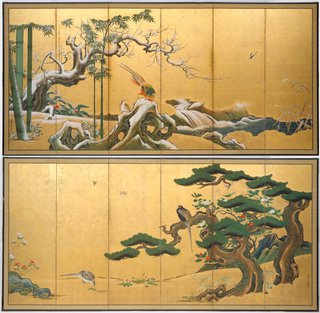
AGNSW collection Kanō Einō Pine, bamboo and plum blossom 17th century
Notice the shimmer of real gold on this pair of Japanese screens.
They are beautifully painted and designed to show off the wealth and power of the noble family who owned them. The screens depict things from nature: the curvy pine tree symbolises courage and the plum blossom, purity. Their forms contrast with the vertical branches of the bamboo, symbolising uprightness. These trees are known as the ‘three friends of winter’ because they don’t wither in the cold. Notice the thin layer of snow that covers some of the branches.
Can you spot some pheasants? Which ones do you think are the male birds?

AGNSW collection Sawankhalok ware Waterpot in the form of a puff fish 14th century-15th century
Look closely at the shape of this little water dropper from Thailand.
Puffer fish have highly elastic stomachs that let them quickly ingest huge amounts of water. The water puffs up their bodies so they can frighten off predators. Their bulbous shape is the perfect inspiration for a pot to store water. This small vessel was used drip water onto inkstones for painting and calligraphy. Notice how the brown glaze on this pot is applied in swirls and semicircles to mimic fish scales.
Did you know that male white-spotted puffer fish create circular patterns in the sand to attract females?

AGNSW collection Guan Wei Revisionary 1998
Do you like to make up stories?
Guan Wei invites us to make up an imaginary story about what could be happening in this multi-panelled painting. The colour blue could be heaven or the ocean, the green areas are perhaps land. Lightning bolts, arrows and dotted lines could be like the features on a map. The eyeless faces, arms, legs add to the mystery.
What story do you think is unfolding in this painting?
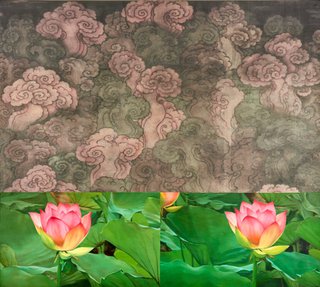
AGNSW collection John Young Cloud and generic flower study #2 Summer 1998-Autumn 1998
Notice how this artwork is divided into three parts.
John Young has combined traditional Chinese cloud patterns with digital images of lotus flowers. The realism of the flowers contrasts with the stylised clouds. Young combines painting and photography, old and new, to perhaps make reference to his Chinese background and an ever-changing world.
Look closely at the flower images. Are they the same? Can you spot any differences?
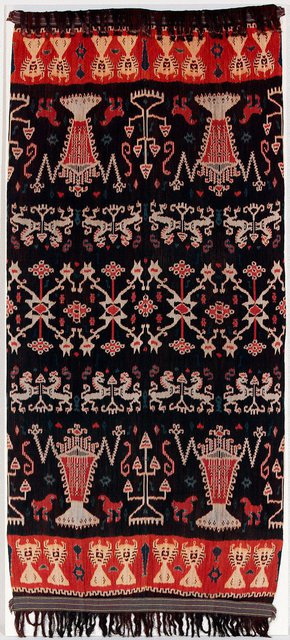
AGNSW collection Man's shawl or mantle (hinggi) with crayfish and 'coat of arms' design circa 1970
Look closely at the detail on this long, woven cloth from Indonesia.
This special textile is known as a hinggi, or man’s shawl. Hinggi are usually woven in pairs. One cloth is worn around the waist as a sarong and the other is worn over the shoulder as a scarf or shawl. This cloth is decorated with little figures and animal forms, such as crayfish. It is believed that special powers can transfer from the animal motifs to the wearer. Crayfish can regrow lost claws, so perhaps this hinggi could help the wearer regenerate and overcome obstacles in life. What do you think?
What other animal shapes you can recognise?
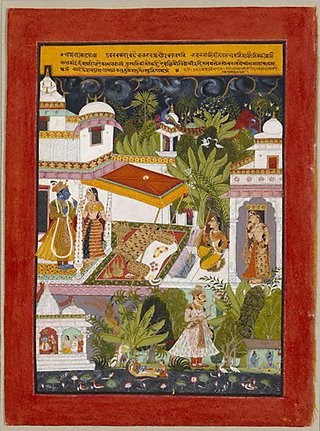
AGNSW collection The month of Ashadha (June-July) circa 1675
How many people can you spot in this Indian miniature painting?
The blue-skinned Hindu god Krishna can be seen in the centre on the left. A maid is showing him to a bed under a canopy. His partner, the goddess Radha, appears through a doorway ready to join him. Other scenes and figures appear in the magnificent palace and gardens that surround them. At the bottom, the god Vishnu sleeps beneath a banana tree. Beside him is a large prince with a bow and arrow. Can you see two men sitting in a hut doing yoga?
Count the different animals and birds can you see.